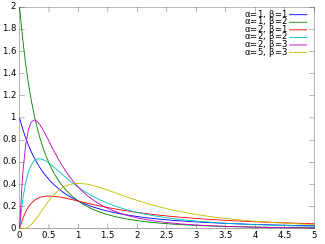|
Probability density function  | |||
|
Cumulative distribution function  | |||
| Parameters |
shape (real) shape (real) | ||
|---|---|---|---|
| Support | |||
| CDF | where is the incomplete beta function | ||
| Mean | |||
| Mode | |||
| Variance | |||
| Skewness | |||
| MGF | Does not exist | ||
| CF | |||
In probability theory and statistics, the beta prime distribution (also known as inverted beta distribution or beta distribution of the second kind[1]) is an absolutely continuous probability distribution. If has a beta distribution, then the odds has a beta prime distribution.
Definitions[edit]
Beta prime distribution is defined for with two parameters α and β, having the probability density function:
where B is the Beta function.
The cumulative distribution function is
where I is the regularized incomplete beta function.
The expected value, variance, and other details of the distribution are given in the sidebox; for , the excess kurtosis is
While the related beta distribution is the conjugate prior distribution of the parameter of a Bernoulli distribution expressed as a probability, the beta prime distribution is the conjugate prior distribution of the parameter of a Bernoulli distribution expressed in odds. The distribution is a Pearson type VI distribution.[1]
The mode of a variate X distributed as is . Its mean is if (if the mean is infinite, in other words it has no well defined mean) and its variance is if .
For , the k-th moment is given by
For with this simplifies to
The cdf can also be written as
where is the Gauss's hypergeometric function 2F1 .
Alternative parameterization[edit]
The beta prime distribution may also be reparameterized in terms of its mean μ > 0 and precision ν > 0 parameters ([2] p. 36).
Consider the parameterization μ = α/(β-1) and ν = β- 2, i.e., α = μ( 1 + ν) and β = 2 + ν. Under this parameterization E[Y] = μ and Var[Y] = μ(1 + μ)/ν.
Generalization[edit]
Two more parameters can be added to form the generalized beta prime distribution :
having the probability density function:
with mean
and mode
Note that if p = q = 1 then the generalized beta prime distribution reduces to the standard beta prime distribution.
This generalization can be obtained via the following invertible transformation. If and for , then .
Compound gamma distribution[edit]
The compound gamma distribution[3] is the generalization of the beta prime when the scale parameter, q is added, but where p = 1. It is so named because it is formed by compounding two gamma distributions:
where is the gamma pdf with shape and inverse scale .
The mode, mean and variance of the compound gamma can be obtained by multiplying the mode and mean in the above infobox by q and the variance by q2.
Another way to express the compounding is if and , then . (This gives one way to generate random variates with compound gamma, or beta prime distributions. Another is via the ratio of independent gamma variates, as shown below.)
Properties[edit]
- If then .
- If , and , then .
- If then .
- If and two iid variables, then with and , as the beta prime distribution is infinitely divisible.
- More generally, let iid variables following the same beta prime distribution, i.e. , then the sum with and .
Related distributions[edit]
- If has an F-distribution, then , or equivalently, .
- If then .
- If then .
- For gamma distribution parametrization I:
- If are independent, then . Note are all scale parameters for their respective distributions.
- For gamma distribution parametrization II:
- If are independent, then . The are rate parameters, while is a scale parameter.
- If and , then . The are rate parameters for the gamma distributions, but is the scale parameter for the beta prime.
- the Dagum distribution
- the Singh–Maddala distribution.
- the log logistic distribution.
- The beta prime distribution is a special case of the type 6 Pearson distribution.
- If X has a Pareto distribution with minimum and shape parameter , then .
- If X has a Lomax distribution, also known as a Pareto Type II distribution, with shape parameter and scale parameter , then .
- If X has a standard Pareto Type IV distribution with shape parameter and inequality parameter , then , or equivalently, .
- The inverted Dirichlet distribution is a generalization of the beta prime distribution.
- If , then has a generalized logistic distribution. More generally, if , then has a scaled and shifted generalized logistic distribution.
Notes[edit]
- ^ a b Johnson et al (1995), p 248
- ^ Bourguignon, M.; Santos-Neto, M.; de Castro, M. (2021). "A new regression model for positive random variables with skewed and long tail". Metron. 79: 33–55. doi:10.1007/s40300-021-00203-y. S2CID 233534544.
- ^ Dubey, Satya D. (December 1970). "Compound gamma, beta and F distributions". Metrika. 16: 27–31. doi:10.1007/BF02613934. S2CID 123366328.
References[edit]
- Johnson, N.L., Kotz, S., Balakrishnan, N. (1995). Continuous Univariate Distributions, Volume 2 (2nd Edition), Wiley. ISBN 0-471-58494-0
- Bourguignon, M.; Santos-Neto, M.; de Castro, M. (2021), "A new regression model for positive random variables with skewed and long tail", Metron, 79: 33–55, doi:10.1007/s40300-021-00203-y, S2CID 233534544











![{\displaystyle p\in [0,1]}](https://wikimedia.org/api/rest_v1/media/math/render/svg/33c3a52aa7b2d00227e85c641cca67e85583c43c)














![{\displaystyle E[X^{k}]}](https://wikimedia.org/api/rest_v1/media/math/render/svg/4dcd54fe6c5cb4afbfcd7bd94c4778d13b8bbc3f)
![{\displaystyle E[X^{k}]={\frac {B(\alpha +k,\beta -k)}{B(\alpha ,\beta )}}.}](https://wikimedia.org/api/rest_v1/media/math/render/svg/30c6530cfd83409026129cc40968169281f41081)


![{\displaystyle E[X^{k}]=\prod _{i=1}^{k}{\frac {\alpha +i-1}{\beta -i}}.}](https://wikimedia.org/api/rest_v1/media/math/render/svg/d0f1689a0ef95460a83f9f53462da32a9b1e8f04)
































































